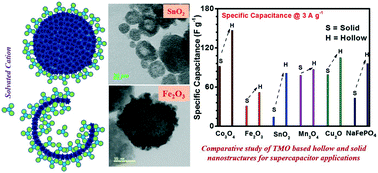Hollow nanostructures of metal oxides as emerging electrode materials for high performance supercapacitors†
Abstract
A targeted strategy of stabilizing hollow nanostructures of metal oxides is proposed for developing next-generation supercapacitors. A nucleation and growth driven mechanism, for obtaining hollow structures, can be utilized to fabricate simple binary to complex ternary oxides. Much superior properties of hollow particles, in comparison to those of their solid or other hierarchical nanostructure counterparts, are proven by comparing with the results of reported studies on electrodes based on Co3O4, Fe2O3, SnO2, Mn3O4, Cu2O, NaFePO4, etc. X-ray diffraction studies show that the unit cell parameters do not change much in both solid and hollow type particles. This proves that, during synthesis, the reaction kinetics leads to the opening or collapse of cavities. The redox sites also remain similar in both morphologies, as confirmed by XPS analysis. Therefore, the improved electrochemical response can be predominantly attributed to the enhanced active surface area, directed ion transport channels and structural stability. The results are compared with the published literature. It is observed that the hollow nanostructures even have the capacity to compete with and beat these transition metal oxide (TMO) based high performing composites based on trendy systems like graphene, rGO or conducting polymers. Therefore, the proposed hollow nanostructures can become useful for large scale industrial applications, owing to their lower weight and density, reduced cost and well understood synthesis protocols.

- This article is part of the themed collection: Crystal engineering for electrochemical applications


 Please wait while we load your content...
Please wait while we load your content...